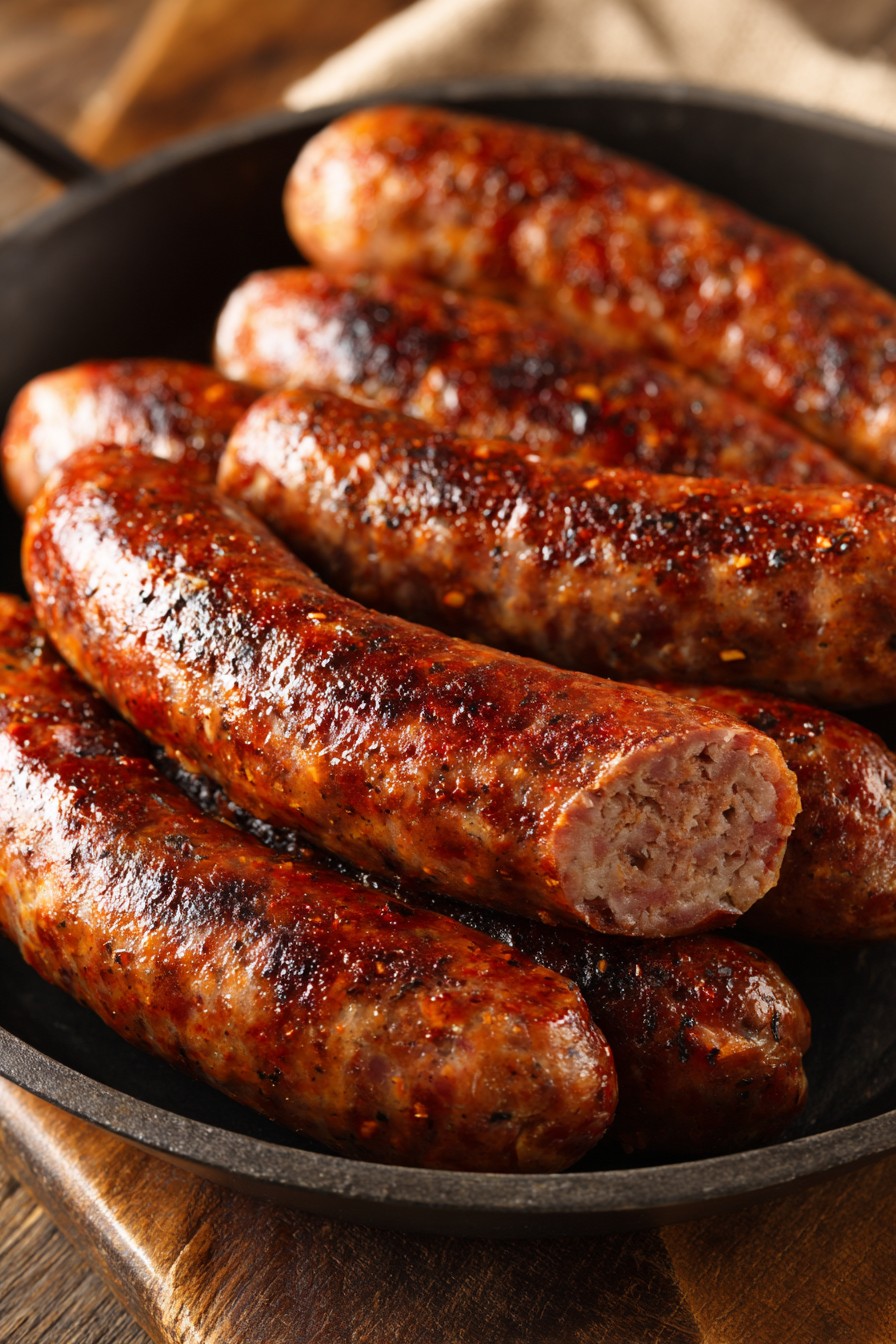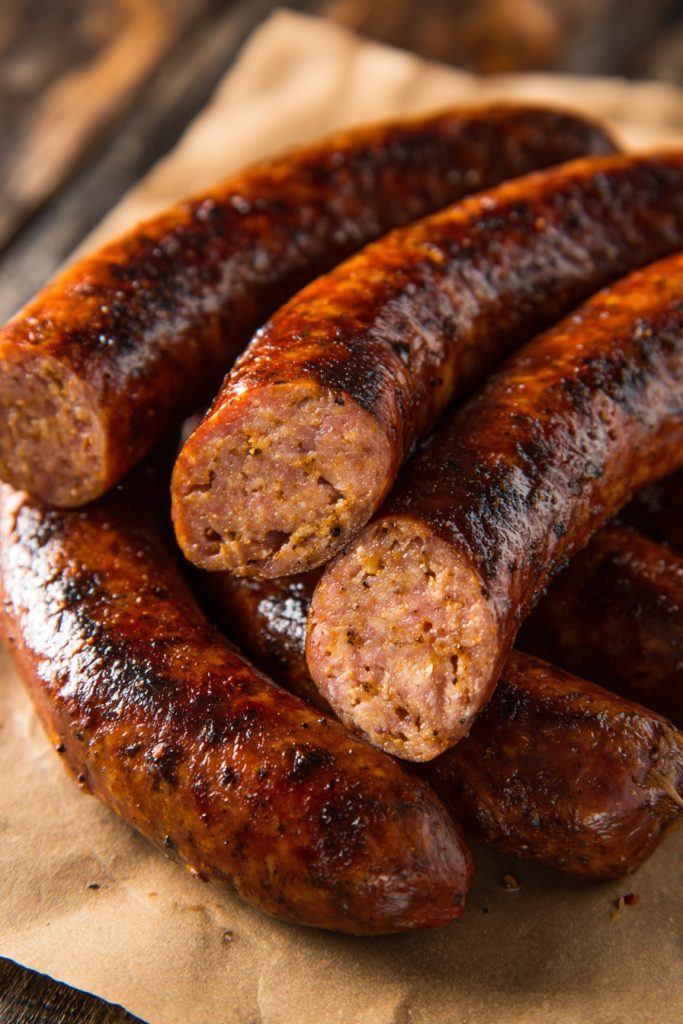Our journey into authentic Cajun cuisine begins with mastering the art of andouille sausage, a cornerstone of Louisiana cooking that delivers robust flavor while offering surprising nutritional benefits when prepared with mindful ingredient selection and cooking techniques.
Why This Recipe Works
- This recipe achieves authentic flavor through the careful balance of smoked paprika, garlic powder, and cayenne pepper, creating that signature spicy, smoky profile while using lean pork shoulder to reduce saturated fat content compared to traditional versions.
- By incorporating apple cider vinegar and natural pork casings, we enhance both flavor complexity and digestive benefits, with the vinegar helping to tenderize the meat while providing probiotic advantages when consumed in moderation.
- The cooking method combines both smoking and gentle simmering to develop deep, layered flavors while ensuring food safety, making this approach suitable for home cooks who want restaurant-quality results with health-conscious modifications.
- We’ve included specific temperature guidelines and timing instructions that guarantee perfect texture every time, eliminating the guesswork that often leads to overcooked or under-seasoned sausage while maintaining optimal protein quality.
- This recipe provides clear substitution options for various dietary needs, including turkey alternatives and spice level adjustments, ensuring everyone can enjoy this Cajun classic while meeting their nutritional goals.
Ingredients
- 3 pounds pork shoulder, trimmed of excess fat and cut into 1-inch cubes
- 2 tablespoons kosher salt
- 1 tablespoon freshly ground black pepper
- 2 tablespoons smoked paprika
- 1 tablespoon garlic powder
- 2 teaspoons cayenne pepper (adjust for heat preference)
- 1 teaspoon dried thyme
- 1 teaspoon dried oregano
- 1/2 teaspoon ground allspice
- 1/4 teaspoon curing salt (pink salt #1), optional for preservation
- 1/4 cup ice water
- 2 tablespoons apple cider vinegar
- Natural pork casings, soaked and rinsed
Equipment Needed
- Meat grinder with medium grinding plate
- Sausage stuffer or KitchenAid attachment
- Smoker or grill with smoking capability
- Digital meat thermometer
- Large mixing bowls
- Kitchen scale
- Parchment paper
- Butcher’s twine
Instructions

Prepare and Season the Meat
Begin by placing your cubed pork shoulder in a large mixing bowl, ensuring all pieces are uniformly sized for consistent grinding. In a separate small bowl, combine the kosher salt, black pepper, smoked paprika, garlic powder, cayenne pepper, dried thyme, dried oregano, ground allspice, and optional curing salt, whisking thoroughly to create an evenly distributed spice blend. Sprinkle this seasoning mixture over the pork cubes, using your hands to massage the spices into every surface of the meat. The thorough incorporation of spices at this stage is crucial for developing the complex flavor profile that defines authentic andouille sausage. Add the ice water and apple cider vinegar to the mixture, continuing to mix until the liquid is fully absorbed. Cover the bowl with plastic wrap and refrigerate for at least 4 hours, though overnight marination will yield superior flavor penetration and texture development.
Grind and Mix the Sausage
Remove the marinated pork from refrigerator and assemble your meat grinder with the medium grinding plate, ensuring all components are thoroughly chilled to maintain proper meat temperature throughout the process. Feed the seasoned pork cubes through the grinder into a clean bowl placed in an ice bath to keep the mixture below 40°F, which is essential for food safety and optimal texture. Once all meat has been ground, use your hands or a stand mixer with paddle attachment to mix the ground meat for 2-3 minutes until it becomes slightly sticky and cohesive—this key step develops the myosin protein that gives sausage its characteristic bind and snap. Test the seasoning by taking a small portion of the mixture, forming it into a patty, and pan-frying until cooked through, then adjust salt or spices as needed before proceeding to stuffing.
Stuff the Sausage Casings
Prepare your sausage stuffer according to manufacturer instructions and carefully slide the pre-soaked natural pork casings onto the stuffing tube, leaving a few inches hanging loose to tie off later. Fill the stuffer chamber with your seasoned sausage mixture, being careful to avoid air pockets, and begin feeding the meat through at a steady, moderate pace to ensure even filling without overpacking. As the casings fill, support them with your free hand to guide the sausage into consistent 6-inch links, twisting every few links to create individual portions. Professional tip: Maintain slight tension on the casing as it fills to achieve uniform density without bursting, and periodically prick any visible air bubbles with a sterilized needle to prevent uneven cooking.
Smoke to Perfection
Preheat your smoker to 180°F using fruitwood chips like apple or cherry, which provide a milder smoke flavor that complements rather than overwhelms the spice profile. Arrange the stuffed sausage links on the smoker racks with adequate space between them to ensure proper smoke circulation and even cooking. Smoke the sausages for 2-3 hours, maintaining consistent temperature and adding wood chips as needed to sustain light smoke, until the internal temperature reaches 150°F on your digital thermometer. The slow smoking process not only imparts that characteristic smoky flavor but also helps develop the firm texture and deep reddish color that distinguishes quality andouille from ordinary sausage varieties.
Complete the Cooking Process
Transfer the smoked sausages to a large pot and cover with water or chicken broth, bringing the liquid to a gentle simmer over medium heat—avoid boiling vigorously as this can cause the casings to split and result in dry, tough texture. Maintain the simmer for 20-30 minutes until the internal temperature reaches 160°F, using your instant-read thermometer to check multiple links for doneness. Remove the cooked sausages from the liquid and place them on a wire rack to cool completely, which allows the proteins to set and flavors to meld while preventing the casings from becoming soggy. For optimal food safety and flavor development, refrigerate the cooled sausages overnight before slicing and using in your favorite recipes.
Tips and Tricks
For those seeking to elevate their andouille sausage-making skills, several advanced techniques can significantly improve both flavor and texture outcomes. When selecting pork shoulder, look for cuts with good marbling but minimal external fat—this balance ensures moist results without excessive greasiness. If you cannot find natural casings, collagen casings work well as a substitute, though they may provide slightly different texture characteristics. For enhanced food safety, consider using curing salt even if you plan to cook the sausage immediately, as it provides an additional layer of protection against bacterial growth while contributing to that characteristic pink color. When grinding meat, keep everything cold by placing your grinder parts in the freezer for 30 minutes before use and working in a cool kitchen environment—this prevents fat smearing and ensures clean cuts through the muscle fibers.
Smoking technique dramatically impacts final flavor; for authentic Louisiana-style andouille, consider using pecan wood instead of fruitwoods for a richer, more robust smoke profile. Maintain consistent smoker temperature by checking every 30 minutes and making small adjustments as needed—fluctuating temperatures can cause uneven cooking and texture issues. If you don’t have a dedicated smoker, you can achieve similar results using a charcoal grill with indirect heat and soaked wood chips wrapped in aluminum foil packets placed directly on the coals. For those monitoring sodium intake, reduce the kosher salt by 25% and compensate with additional herbs and spices like extra garlic powder, onion powder, or a pinch of celery seed to maintain flavor complexity without excessive salt content.
Storage considerations are crucial for food safety and quality preservation. Fresh andouille sausage should be used within 2 days or frozen for up to 3 months—vacuum sealing before freezing provides the best protection against freezer burn. When freezing, portion the sausages into meal-sized quantities and label with dates to ensure proper rotation. For cooked andouille, proper cooling is essential; spread the sausages in a single layer on a baking sheet and refrigerate uncovered until completely cold before transferring to airtight containers. This method prevents condensation that can lead to sogginess and potential bacterial growth. When reheating, avoid microwaving which can create rubbery texture—instead, gently warm in a skillet with a small amount of liquid or slice and incorporate directly into dishes like jambalaya or gumbo.
Recipe Variations
- For a poultry-based alternative with reduced saturated fat, substitute the pork shoulder with an equal weight of skinless turkey thighs mixed with 20% turkey fat or olive oil to maintain moisture. Adjust seasonings by increasing smoked paprika to 3 tablespoons and adding 1 teaspoon of liquid smoke to compensate for the milder flavor profile of poultry. This variation provides all the spicy, smoky characteristics of traditional andouille while offering a leaner protein option that aligns with heart-healthy dietary guidelines, making it suitable for those monitoring cholesterol intake or preferring white meat alternatives.
- Create a vegetarian andouille using a base of vital wheat gluten combined with cooked lentils and mushrooms for texture complexity. Season with the same spice blend but increase smoked paprika to 3 tablespoons and add 2 tablespoons of nutritional yeast for umami depth. The binding properties of wheat gluten allow this meat-free version to maintain firm texture when sliced, making it ideal for vegetarian jambalaya or gumbo while providing complete plant-based protein with fiber benefits that traditional sausage lacks.
- For those sensitive to heat but wanting authentic flavor, reduce cayenne pepper to 1/2 teaspoon and incorporate 2 tablespoons of sweet paprika alongside the smoked variety. Add 1 tablespoon of brown sugar to balance any remaining heat and consider including 1 teaspoon of ground coriander for additional flavor complexity without spiciness. This mild variation maintains the essential character of andouille while being accessible to children or those with pepper sensitivities, proving that you don’t need excessive heat to achieve depth of flavor in Cajun cuisine.
- Experiment with international flavor fusion by replacing traditional Cajun spices with 2 tablespoons of harissa paste, 1 tablespoon of ground cumin, and 1 teaspoon of ground cinnamon while keeping the smoking process unchanged. This North African-inspired variation creates exciting new culinary possibilities while maintaining the sausage-making techniques that ensure proper texture and food safety, demonstrating how global flavors can transform classic preparations into innovative dishes that still honor their culinary origins.
Frequently Asked Questions
Can I make andouille sausage without a meat grinder?
While a meat grinder provides the ideal texture for authentic andouille, you can achieve satisfactory results using a food processor with careful technique. Cut your seasoned pork into 1/2-inch cubes and freeze for 20 minutes until firm but not solid. Working in small batches, pulse the meat in the food processor using 1-second pulses until it reaches a coarse grind consistency, being careful not to overprocess into a paste. The key is maintaining temperature control and stopping immediately when the desired texture is achieved. This method may produce slightly less uniform results than proper grinding, but it allows home cooks without specialized equipment to create homemade sausage with superior flavor to commercial alternatives while controlling ingredient quality and sodium content.
What’s the purpose of curing salt in this recipe?
Curing salt, specifically Prague powder #1, serves multiple important functions in sausage making beyond preservation. It contains sodium nitrite which inhibits bacterial growth, particularly preventing botulism in smoked products, while also developing the characteristic pink color associated with cured meats. The nitrite reacts with myoglobin in the meat during cooking to create that visual signature, and it contributes to the distinctive flavor profile that distinguishes andouille from fresh sausage varieties. For those concerned about nitrites, understand that many vegetables naturally contain nitrates that convert to nitrites in the body, and the small amount used in this recipe falls well within safety guidelines. However, if you prefer to omit it, increase the smoking time slightly and plan to use the sausage within 2 days or freeze immediately.
How can I tell when the sausage is properly cooked?
Determining doneness requires both temperature verification and visual/textural assessment. Always use a digital instant-read thermometer inserted into the thickest part of multiple sausages to confirm they’ve reached 160°F internally, which ensures food safety by eliminating harmful bacteria. Additionally, properly cooked andouille will feel firm to the touch but still have slight springback when pressed, and the casings should be taut without splitting. The color should be consistently reddish-brown throughout with no pink areas visible when sliced. During the simmering stage, properly cooked sausage will float to the surface of the liquid, providing another visual cue. Remember that carryover cooking will raise the temperature another 5-10 degrees during resting, so remove from heat at 155°F if planning to serve immediately rather than cooling for storage.
Can I adjust the spice level for different preferences?
Absolutely, andouille sausage is highly adaptable to various spice tolerances while maintaining its essential character. For mild versions, reduce cayenne pepper to 1/2 teaspoon and incorporate 1 additional tablespoon of sweet paprika to maintain volume in the spice blend. Medium heat lovers can follow the recipe as written, while those seeking extra heat can increase cayenne to 1 tablespoon and add 1 teaspoon of crushed red pepper flakes. For customized heat control, prepare the spice mixture without cayenne and divide your ground meat into portions, adding different amounts of heat to each batch. This approach allows one sausage-making session to accommodate various preferences within the same household while ensuring everyone enjoys this Cajun classic at their comfort level.
What’s the best way to store homemade andouille?
Proper storage is crucial for food safety and quality preservation. Fresh uncooked andouille should be refrigerated at 40°F or below and used within 2 days, or frozen for up to 3 months for optimal quality. For freezing, arrange sausages in a single layer on a parchment-lined baking sheet until solid, then transfer to freezer bags removing as much air as possible—this prevents freezer burn and allows individual sausages to be removed as needed. Cooked andouille will keep refrigerated for 5-7 days when stored in airtight containers. For longer preservation, you can vacuum seal cooked sausages and freeze for 2-3 months, though some texture changes may occur upon thawing. Always label packages with contents and dates, and never refreeze previously frozen raw sausage after thawing.
Summary
This authentic andouille sausage recipe delivers robust Cajun flavors through careful spice balancing and proper smoking technique, while offering health-conscious modifications and clear instructions that guarantee success for home cooks of all experience levels.
Authentic Andouille Sausage
6
servings45
minutes3
minutesIngredients
Instructions
- 1 Season pork cubes with spice mixture, add liquids, refrigerate 4+ hours
- 2 Grind meat using medium plate, mix until sticky and cohesive
- 3 Stuff into prepared casings, forming 6-inch links
- 4 Smoke at 180°F for 2-3 hours until internal temperature reaches 150°F
- 5 Simmer in liquid 20-30 minutes until 160°F internal temperature
- 6 Cool completely on wire rack, refrigerate overnight before use



